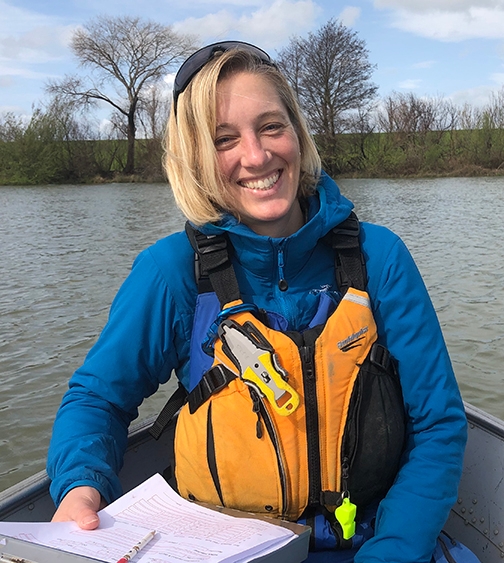
UC Davis doctoral candidate Ann Holmes has--and she's doing research on what's in their guano (feces).
Holmes will be among the six doctoral students showcasing their research at the UC Davis Bohart Museum of Entomology open house themed “Time Flies When You Are Studying Insects: Cutting Edge Student Research,” on Saturday, Jan. 18. The event, free and family friendly, will be held from 1 to 4 p.m. in Room 1124 of the Academic Surge Building on Crocker Lane, UC Davis campus.
Holmes, affiliated with the Graduate Group in Ecology, Department of Animal Science, and the Genomic Variation Laboratory, says that "Insects in bat poop are hard to identify because they have been digested, but I can use DNA to determine which insects are there. We care about which insects bats eat because bats are natural pest controllers. With plenty of bats we can use less pesticide on farms and less mosquito repellent on ourselves."
She does not have any results yet (coming summer 2020), "but we expect to see some of the common agricultural pests such as corn earworm as well as mosquitoes and midges. Previous studies using microscopic examination are rarely able to ID the prey to species level, but DNA may be able to change that!"
The insects eat crops such as rice, so bats provide a valuable service to farmers, Holmes points out. "Hungry bats can eat as much as their own body weight in insects each night. Visitors can expect to learn how DNA is used to detect insects in bat guano."
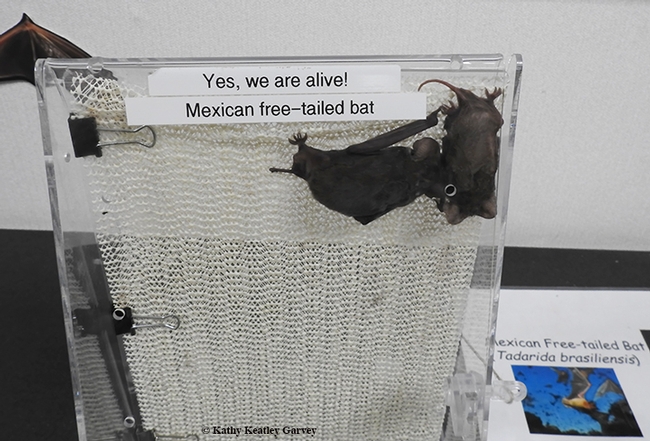
Her research interests? In addition to bats, they include conservation genetics, environmental DNA (eDNA), molecular ecology, fish, crustaceans, plankton, aquatic food webs, and marine ecology.
And the bats? Every summer, some quarter-million migrating Mexican free-tailed bats nest in the Yolo Causeway's expansion joints where they give birth. They fly out at dusk to feast on insects.
The Bohart Museum open house will feature "a diversity of topics,” said Tabatha Yang, education and outreach coordinator for the Bohart Museum. “I just love how this university excels at interdisciplinary research. We may be the Entomology and Nematology Department but we are connected to so many fields of research. “Our grads are our future's hope and here they are inspiring others."
Other doctoral students who will showcase their research are:
- Entomologist Yao Cai of the Joanna Chiu lab, UC Davis Department of Entomology and Nematology,
- Entomologist Charlotte Herbert Alberts, who studies assassin flies with major professor Lynn Kimsey, director of the Bohart Museum of Entomology and professor of entomology
- Entomologist-ant specialist Zachary Griebenow of the Phil Ward lab, UC Davis Department of Entomology and Nematology
- Forest entomologist Crystal Homicz who studies with Joanna Chiu and research forest entomologist Chris Fettig, Pacific Southwest Research Station, USDA Forest Service, Davis. (She formerly studied with the late Steve Seybold of USDA Forest Service and the Department of Entomology and Nematology.)
- Forensic entomologist Alexander Dedmon, who studies with Robert Kimsey, UC Davis Department of Entomology and Nematology
The line-up:
Yao Cai
Yao Cai, a fourth-year doctoral student, studies circadian clock in insects. “Using Drosophila melanogaster (fruit fly) and Danaus plexippus (monarch butterfly), as models, we seek to understand how these insects receive environmental time cues and tell time, how they organize their daily rhythms in physiology and behavior, such as feeding, sleep and migration (in monarch butterfly),” Cai said.
“Since clock design is conserved from fly to human, understanding how fly clock works can be translated into knowledge and treatment for people who undergo clock disruption in their daily lives, such as jet lag, shift work,” Cai said.
Visitors will learn how fruit flies and monarch butterflies tell time, why the clock is important to them, and the tools scientists use to study circadian clock.
Zachary Griebenow
Zachary Griebenow, a third-year doctoral student, will be showcasing or discussing specimens of the ant subfamily Leptanillinae, most of them male.
“I will be showing specimens of the Leptanillinae under the microscope, emphasizing the great morphological diversity observed in males and talking about my systematic revision of the subfamily," he said. "In particular, I want to explain how the study of an extremely obscure group of ants can help us understand the process of evolution that has given rise to all organisms."
Crystal Homicz
“Did you know that between 1987 and 2017 bark beetles were responsible for more tree death than wildfire?” asks Crystal Homicz, a first-year doctoral student. “Bark beetles are an incredibly important feature of forests, especially as disturbance agents. My research focuses on how bark beetles and fire interact, given that these are the two most important disturbance agents of the Sierra Nevada. At my table, I will discuss how the interaction between bark beetles and fire, why bark beetles and fire are important feature of our forest ecosystem, and I will discuss more generally the importance of bark beetles in many forest systems throughout North America.
“I will have several wood samples, insect specimens and photographs to display what bark beetle damage looks like, and the landscape level effects bark beetles have. I will also have samples of wood damage caused by other wood boring beetles and insects. My table will focus widely on the subject of forest entomology and extend beyond beetle-fire interactions.”
Visitors, she said, can expect to leave with a clear understanding of what bark beetles are and what they do, as well as a deeper understanding of the importance of disturbance ecology in our temperate forests.
Charlotte Alberts
Charlotte Alberts, a fifth-year doctoral candidate, will display assassin flies and their relatives, as well as examples of prey they eat and/or mimic. Visitors can expect to learn about basic assassin fly ecology and evolution.
Alberts studies the evolution of assassin flies (Diptera: Asilidae) and their relatives. “Assassin flies are voracious predators on other insects and are able to overcome prey much larger than themselves,” she said. “Both adult and larval assassin flies are venomous. Their venom consists of neurotoxins that paralyze their prey, and digestive enzymes that allow assassin flies to consume their prey in a liquid form. These flies are incredibly diverse, ranging in size from 5-60mm, and can be found all over the world! With over 7,500 species, Asilidae is the third most specious family of flies. Despite assassin flies being very common, most people do not even know of their existence. This may be due to their impressive ability to mimic other insects, mainly wasps, and bees.”
For her thesis, she is trying to resolve the phylogenetic relationships of Asiloidea (Asilidae and their relatives) using Ultra Conserved Elements (UCEs), and morphology. "I am also interested in evolutionary trends of prey specificity within Asilidae, which may be one of the major driving forces leading to this family's diversity."
Alexander Dedmon
Forensic entomologist Alex Dedmon, a sixth-year doctoral student, will display tools and text and explain what forensic entomology is all about. "My research focuses on insect succession. In forensic entomology, succession uses the patterns of insects that come and go from a body. These patterns help us estimate how long a person has been dead. Visitors can expect to learn about the many different ways insects can be used as evidence, and what that evidence tells us."
Dedmon recently won first place in a contest at the Entomological Society of America meeting in St. Louis. As he explained in a Facebook post: "Trécé, Inc. is a company that creates olfactory baits and traps for insects. They had a contest at their booth looking for ideas to expand their research and product line. Most of this sort of thing is generally used for surveillance of insect pests, which I don't do much work in. Still, I figured I had nothing to lose by at least trying. So, I pointed out that forensic entomologists often have to sample blowfly populations from the region in order to establish species presence for future casework"
"To sample those flies, we usually use a carrion source like a dead pig. Unfortunately, carrion tends to be surprisingly expensive. Also, we have to usually place it in a remote location (the general public doesn't care much for seeing rotting pigs)."
"However, we know that blowflies mainly orient themselves off of smell. In other words, they are attracted by the aromatic compounds emitted as part of the decomposition process. It's these compounds that make the pigs "stink." Many of them have been identified, and have wonderfully illustrative names like 'cadaverine.' So, if those compounds were applied to a sticky trap, you'd (hypothetically) have a cheaper, less unsightly method for sampling blowflies."
"Not bad for improvising an idea on the spot," he quipped.
Other Activities at the Open House
The family craft activity will be painting rocks, which can be taken home or hidden around campus. "Hopefully some kind words on rocks found by random strangers can also make for a kinder better future,” Yang said.
In addition to meeting and chatting with the researchers, visitors can see insect specimens (including butterflies and moths), meet the critters in the live “petting zoo” (including Madagascar hissing cockroaches, walking sticks and tarantulas) and browse the gift shop, containing books, insect-themed t-shirts and sweatshirts, jewelry, insect-collecting equipment and insect-themed candy.
The Bohart Museum, founded by noted entomologist Richard M. Bohart (1913-2007), houses a global collection of nearly eight million specimens. It is also the home of the seventh largest insect collection in North America, and the California Insect Survey, a storehouse of insect biodiversity.
The insect museum is open to the public Mondays through Thursdays from 9 a.m. to noon and 1 to 5 p.m., except on holidays. More information on the Bohart Museum is available on the website at http://bohart.ucdavis.edu or by contacting (530) 752-0493 or bmuseum@ucdavis.edu.
Attached Images:
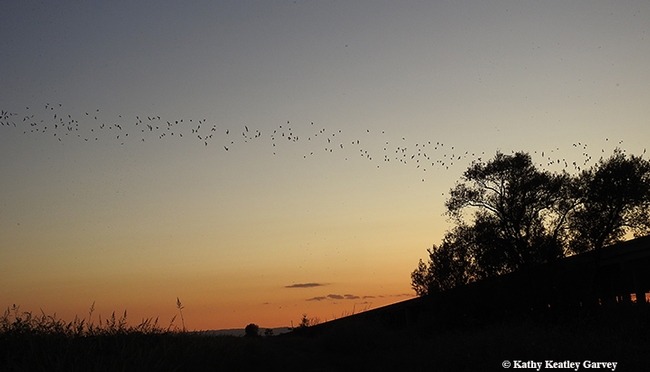
Mexican free-tailed bats leaving Yolo Causeway at dusk on Sept. 10, 2019. (Photo by Kathy Keatley Garvey)
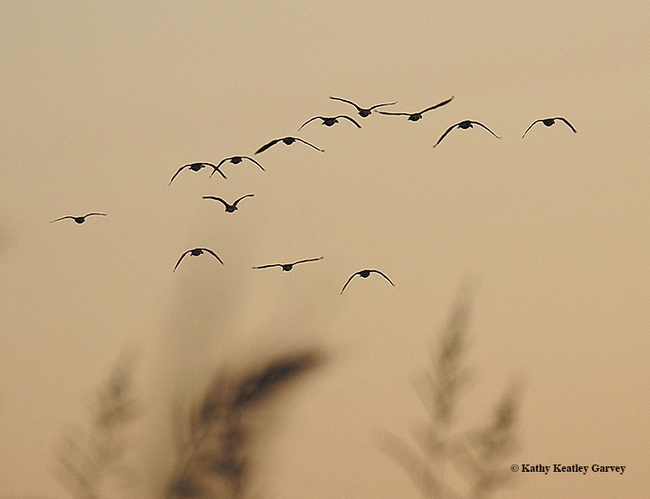
Mexican free-tailed bats ready to catch insects at the Yolo Causeway. (Photo by Kathy Keatley Garvey)
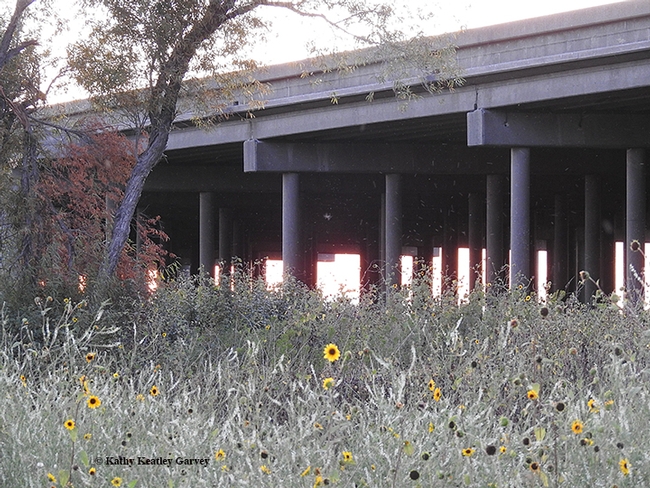
Thousands of bats nest in the Yolo Causeway during the summer. (Photo by Kathy Keatley Garvey)
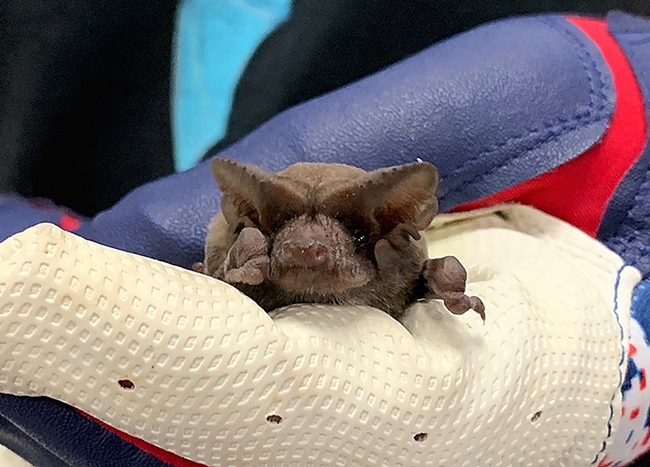
This is an image of a bat that Ann Holmes studies. (Photo by Shayan Kaveh)